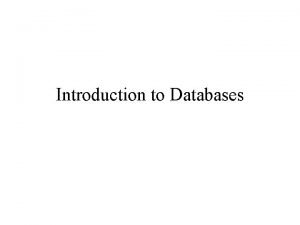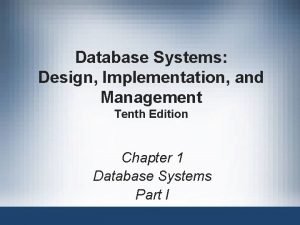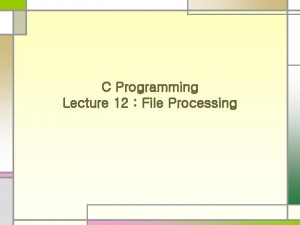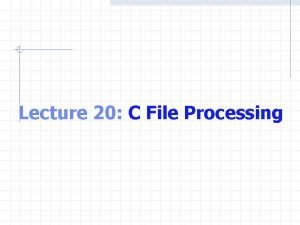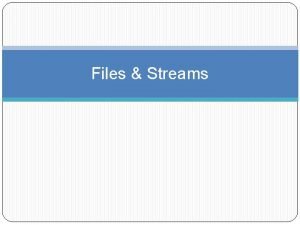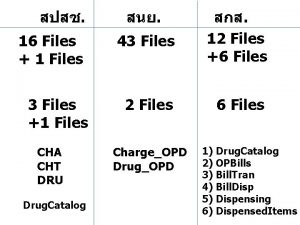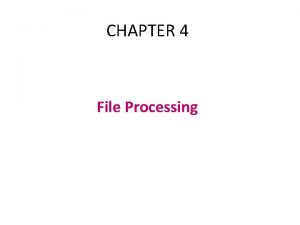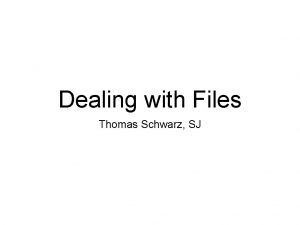File Processing Introduction Files are used for permanent















- Slides: 15

File Processing

Introduction • Files are used for permanent retention of large amount of data – Storage of data in variables is temporary • Files are stored on secondary storage devices – Magnetic disks, optical disks, tapes

Data Hierarchy • Bit: manipulated by computer circuitry – binary digit: 0 or 1, • Byte: commonly composed of 8 bits – Decimal digits, letters, special symbols • • Field: a group of bytes that conveys meaning Record: composed of related fields File: a group of related records Database: a group of related files

Files and Streams • C++ views files as a sequence of bytes ios istream ostream – No concept of record • When a file is opened, iostream an object is created and a stream is associated ifstream ofstream with it • To process file in C++, fstream <iostream>, <fstream> must be included.

Creating a Sequential File – Maintain Bank Balances #include<iostream> #include<fstream> void main() { ofstream client. F(“clients. dat”, ios: : out); if (!client. F){ //overloaded ios operator ! cerr<<“File could not be opened”<<endl; exit(1); } int account; char name[30]; double balance; while (cin>>account>>name>>balance){ client. F<<account<<name<<balance<<‘n’; } } • Files are opened by creating objects of ifstream, or fstream • Explicitly close file: client. F. close();

Reading From a Sequential File #include<iostream> #include<fstream> #include<iomanip> void main() { ifstream client. F(“clients. dat”, ios: : in); if (!client. F) … int account; char name[30]; double balance; while (client. F>>account>>name>>balance){ cout<<setiosflags(ios: : left)<<setw(10) <<account<<setw(13)<<name<<setw(7) <<setprecision(2) <<resetiosflags(ios: : left) <<balance<<‘n’; } }

Reposition File Position Pointer • Both istream and ostream provide member function for repositioning – seekg(), seekp() istream file. Obj(“abc. dat”); //position to the nth byte of file. Obj. seekg(n, ios: : beg); //position n bytes forward from current position file. Obj. seekg(n, ios: : cur); //position n bytes back from end of file. Obj. seekg(n, ios: : end); //get current position long loc = file. Obj. tellg();

Updating Sequential Files • There is no easy way! 300 White 0. 00 400 James 0. 20 300 Worthington 0. 00 – If record were rewritten beginning at the same location 300 Worthingto n 0. 00 mes 0. 20 • Inefficient / Awkward method – Copy all records before White to new file nf – Append Worthington record to nf – Append all records after White to nf

Random-Access Files • Sequential access files are inappropriate for instant-access applications – Airline reservation systems, banking systems – Require individual records to be accessed directly without searching through others • C++ does not impose structure on file – Application must create random-access files

Create Random Access Files • Require records have same fixed length – Program can calculate the exact location of any record relative to the beginning of files – << should not be used int number; //number is a 4 -byte integer out. File << number; //print 1 to 11 digits, //each digit requires 1 byte – Use write() instead out. File. write(reinterpret_cast<const char*>(&number), sizeof(number)); //always write 4 bytes

Create Random Access Files • Require records have same fixed length Struct client. D { int acct; char la[15]; char fi[10]; double ba; }; void main(){ ofstream out. F(“credit. dat”, ios: : binary); if (!out. F) … client. D client = {0, “”, ””, 0. 0}; for (int i=0; i<100; i++) out. F. write(reinterpret_cast<const char*>(&client), sizeof(client)); }

Write to Random Access Files • Records have fixed length sizeof(client) void main(){ ofstream out. F(“credit. dat”, ios: : binary); if (!out. F) … client. D client; cin >> client. acct; //1. . 100 while (client. acct>0 && client. acct<=100) { cin>>client. fi>>client. la>>client. ba; //Put file position pointer for object out. F //to the right byte location out. F. seekp((client. acct-1)*sizeof(client)); out. F. write(reinterpret_cast<const char*>(&client), sizeof(client)); cin>>client. acct; }

Read from Random Access Files • Records have fixed length sizeof(client) void main(){ ifstream in. F(“credit. dat”, ios: : in); if (!in. F) … client. D client; in. F. read(reinterpret_cast<char*>(&client), sizeof(client)); while (in. F && !in. F. eof()) { if (client. acct != 0) output. Line(cout, client); in. F. read(reinterpret_cast<char*>(&client), sizeof(client)); } }

Read from Random Access Files void output. Line(ostream &output, const client. D &c){ output << setiosflags(ios: : left) << setw(10) << c. acct << setw(16) << c. la << setw(11) << c. fi << setw(10) << setprecision(2)<<resetiosflags(ios: : left) << c. ba <<endl; }

Summary • C++ imposes no structure on a file. It views each file as a sequential stream of bytes. • Files are opened by instantiating objects of stream classes ifstream, ofstream, and fstream. • Streams provide communication channels between files and programs. • A convenient way to implement randomaccess files is by using only fixed-length records.
 Mikael ferm
Mikael ferm File mode python
File mode python Cjis security levels
Cjis security levels Ncic hosts restricted files and non-restricted files
Ncic hosts restricted files and non-restricted files File-file yang dibuat oleh user pada jenis file di linux
File-file yang dibuat oleh user pada jenis file di linux Difference between logical file and physical file
Difference between logical file and physical file Fungsi dari create file pada operasi-operasi file (cont.)
Fungsi dari create file pada operasi-operasi file (cont.) Distributed file system definition
Distributed file system definition Markup tag tells the web browser
Markup tag tells the web browser In a file-oriented information system, a transaction file
In a file-oriented information system, a transaction file File processing system
File processing system File based system example
File based system example Evolution of file system data processing
Evolution of file system data processing File processing in c
File processing in c Fhand python
Fhand python C file processing
C file processing











